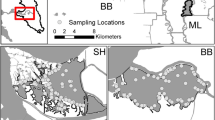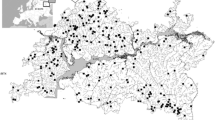Abstract
An extensive literature base worldwide demonstrates how spatial differences in estuarine fish assemblages are related to those in the environment at (bio)regional, estuary-wide or local (within-estuary) scales. Few studies, however, have examined all three scales, and those including more than one have often focused at the level of individual environmental variables rather than scales as a whole. This study has identified those spatial scales of environmental differences, across regional, estuary-wide and local levels, that are most important in structuring ichthyofaunal composition throughout south-western Australian estuaries. It is the first to adopt this approach for temperate microtidal waters. To achieve this, we have employed a novel approach to the BIOENV routine in PRIMER v6 and a modified global BEST test in an alpha version of PRIMER v7. A combination of all three scales best matched the pattern of ichthyofaunal differences across the study area (ρ = 0.59; P = 0.001), with estuary-wide and regional scales accounting for about twice the variability of local scales. A shade plot analysis showed these broader-scale ichthyofaunal differences were driven by a greater diversity of marine and estuarine species in the permanently-open west coast estuaries and higher numbers of several small estuarine species in the periodically-open south coast estuaries. When interaction effects were explored, strong but contrasting influences of local environmental scales were revealed within each region and estuary type. A quantitative decision tree for predicting the fish fauna at any nearshore estuarine site in south-western Australia has also been produced. The estuarine management implications of the above findings are highlighted.







Similar content being viewed by others
Notes
While both of these studies did include measurements for the latitude and/or longitude of each estuary to capture their geographical differences, these data were continuous rather than categorical and thus did not reflect a regional-scale classification, e.g. a grouping of estuaries according to bioregion.
References
Ayvazian, S.G., and G.A. Hyndes. 1995. Surf-zone fish assemblages in south-western Australia: do adjacent nearshore habitats and the warm Leeuwin current influence the characteristics of the fish fauna? Marine Biology 122: 527–536.
Barinova, S.S., A. Petro, and E. Nevo. 2011. Comparative analysis of algal biodiversity in the rivers of Israel. Central European Journal of Biology 6: 246–259.
Batteen, M.L., and H.A. Miller. 2009. Process-oriented modeling studies of the 5500-km-long boundary flow off western and southern Australia. Continental Shelf Research 29: 702–718.
Beckley, L.E., B.A. Muhling, and D.J. Gaughan. 2009. Larval fishes off Western Australia: influence of the Leeuwin current. Journal of the Royal Society of Western Australia 92: 101–109.
Bedoya, D., E.S. Manolakos, and V. Novotny. 2011. Prediction of biological integrity based on environmental similarity—revealing the scale-dependant link between study area and top environmental predictors. Water Research 45: 2359–2374.
Bray, J.R., and J.T. Curtis. 1957. An ordination of the upland forest communities of Southern Wisconsin. Ecological Monographs 27: 325–349.
Clarke, K.R. 1993. Non-parametric multivariate analyses of changes in community structure. Australian Journal of Ecology 18: 117–143.
Clarke, K.R., and M. Ainsworth. 1993. A method of linking multivariate community structure to environmental variables. Marine Ecology Progress Series 92: 205–219.
Clarke, K.R., and R.N. Gorley. 2006. PRIMER v6: user manual/tutorial, 190. Plymouth: PRIMER-E.
Clarke, K.R., M.G. Chapman, P.J. Somerfield, and H.R. Needham. 2006. Dispersion-based weighting of species counts in assemblage analyses. Marine Ecology Progress Series 320: 11–27.
Clarke, K.R., P.J. Somerfield, and R.N. Gorley. 2008. Testing of null hypotheses in exploratory community analyses: similarity profiles and biota-environment linkage. Journal of Experimental Marine Biology and Ecology 366: 56–69.
Clarke, K.R., J.R. Tweedley, and F.J Valesini. 2013. Simple shade plots aid better long-term choices of data pre-treatment in multivariate assemblage studies. Journal of the Marine Biological Association of the United Kingdom. doi:10.1017/S0025315413001227
Davies, J.L. 1964. A morphogenic approach to world shorelines. Zeitschrift für Geomorphologie 8: 127–142.
Department of Defence. 2011. Australian national tide tables 2011. Canberra: Australian Hydrographic.
Edgar, G.J., N.S. Barrett, and P.R. Last. 1999. The distribution of macroinvertebrates and fishes in Tasmanian estuaries. Journal of Biogeography 26: 1169–1189.
Elliott, M., and K.L. Hemingway. 2002. Fishes in estuaries, 636. Oxford: Blackwell.
Fox, N.J., and L.E. Beckley. 2005. Priority areas for conservation of Western Australian coastal fishes: a comparison of hotspot, biogeographical and complementarity approaches. Biological Conservation 125: 399–410.
Gee, J.H., and P.A. Gee. 1991. Reactions of gobioid fishes to hypoxia: buoyancy control and aquatic surface respiration. Copeia 1991: 17–28.
Gentilli, J. 1971. Climate of Australia and New Zealand. World Survey of Climatology, 405. Amsterdam: Elsevier.
Gill, H.S., and I.C. Potter. 1993. Spatial segregation amongst goby species within an Australian estuary, with a comparison of the diets and salinity tolerance of the two most abundant species. Marine Biology 117: 515–526.
Gomon, M., D. Bray, and R. Kuiter. 2008. Fishes of Australia’s Southern Coast, 928. Australia: Reed New Holland.
Guidi, L., F. Ibanez, V. Calcagno, and G. Beaugrand. 2008. A new procedure to optimize the selection of groups in a classification tree: applications for ecological data. Ecological Modelling 220: 451–461.
Harrison, T.D. 2002. Preliminary assessment of the biogeography of fishes in South African estuaries. Marine and Freshwater Research 53: 479–490.
Harrison, T.D. 2004. Physico-chemical characteristics of South African estuaries in relation to the zoogeography of the region. Estuarine, Coastal and Shelf Science 61: 73–87.
Harrison, T.D., and A.K. Whitfield. 2006a. Estuarine typology and the structuring of fish communities in South Africa. Environmental Biology of Fishes 75: 269–293.
Harrison, T.D., and A.K. Whitfield. 2006b. Temperature and salinity as primary determinants influencing the biogeography of fishes in South African estuaries. Estuarine, Coastal and Shelf Science 66: 335–345.
Harrison, T.D., and A.K. Whitfield. 2008. Geographical and typological changes in fish guilds of South African estuaries. Journal of Fish Biology 73: 2542–2570.
Hodgkin, E.P., and P. Hesp. 1998. Estuaries to salt lakes: Holocene transformation of the estuarine ecosystems of south-western Australia. Marine and Freshwater Research 49: 183–201.
Hoeksema, S.D., B.M. Chuwen, and I.C. Potter. 2006. Massive mortalities of the black bream Acanthopagrus butcheri (Sparidae) in two normally-closed estuaries, following extreme increases in salinity. Journal of the Marine Biological Association of the United Kingdom 86: 893–897.
Hutchins, J.B., and A.F. Pearce. 1994. Influence of the Leeuwin current on recruitment of tropical reef fishes at Rottnest Island, Western Australia. Bulletin of Marine Science 54: 245–255.
Jackson, D.A., and H.H. Harvey. 1989. Biogeographic associations in fish assemblages: local vs regional processes. Ecology 70: 1472–1484.
Legendre, P., and L. Legendre. 1998. Numerical ecology. Second English edition. Developments in Environmental Modelling 20 853. Amsterdam: Elsevier.
Leibold, M.A., M. Holyoak, N. Mouquet, P. Amarasekare, J.M. Chase, M.F. Hoopes, R.D. Holt, J.B. Shurin, R. Law, D. Tilman, M. Loreau, and A. Gonzalez. 2004. The metacommunity concept: a framework for multi-scale community ecology. Ecology Letters 7: 601–613.
Ley, J.A. 2005. Linking fish assemblages and attributes of mangrove estuaries in tropical Australia: criteria for regional marine reserves. Marine Ecology Progress Series 305: 41–57.
Masselink, G., and C.B. Pattiaratchi. 2001. Seasonal changes in beach morphology along the sheltered coastline of Perth, Western Australia. Marine Geology 172: 243–263.
Nicolas, D., J. Lobry, M. Lepage, B. Sautour, O. Le Pape, H. Cabral, A. Uriarte, and P. Boë. 2010. Fish under influence: a macroecological analysis of relations between fish species richness and environmental gradients among European tidal estuaries. Estuarine, Coastal and Shelf Science 86: 137–147.
Nobriga, M.L., F. Feyrer, R.D. Baxter, and M. Chotkowskis. 2005. Fish community ecology in an altered river delta: spatial patterns in species composition, life history strategies and biomass. Estuaries 28: 776–785.
Perissinotto, R., D.D. Stretch, A.K. Whitfield, J.B. Adams, A.T. Forbes, and N.T. Demetriades. 2010. Ecosystem functioning of temporarily open/closed estuaries in South Africa. In Estuaries: types, movement patterns and climatic impacts, ed. J.R. Crane and A.E. Solomon, 1–69. New York: Nova Science.
Potter, I.C., and G.A. Hyndes. 1999. Characteristics of the ichthyofaunas of southwestern Australian estuaries, including comparisons with holarctic estuaries and estuaries elsewhere in temperate Australia: a review. Australian Journal of Ecology 24: 395–421.
Potter, I.C., L.E. Beckley, A.K. Whitfield, and R.C.J. Lenanton. 1990. Comparisons between the roles played by estuaries in the life cycles of fishes in temperate Western Australia and Southern Africa. Environmental Biology of Fishes 28: 143–178.
Potter, I.C., B.M. Chuwen, S.D. Hoeksema, and M. Elliott. 2010. The concept of an estuary: a definition that incorporates systems which can become closed to the ocean and hypersaline. Estuarine, Coastal and Shelf Science 87: 497–500.
Potter, I.C., J.R. Tweedley, M.E. Elliott, and A.K. Whitfield. 2013. The ways in which fish use estuaries: a refinement and expansion of the guild approach. Fish and Fisheries. doi:10.1111/faf.12050.
Ramos, S., R.K. Cowen, P. Ré, and A.A. Bordalo. 2006. Temporal and spatial distributions of larval fish assemblages in the Lima estuary (Portugal). Estuarine, Coastal and Shelf Science 66: 303–314.
Ranasinghe, R., and C. Pattiaratchi. 1999. The seasonal closure of tidal inlets: Wilson Inlet—a case study. Coastal Engineering 37: 37–56.
Reygondeau, G., O. Maurym, G. Beaugrand, J. Fromentin, A. Fonteneau, and P. Cury. 2012. Biogeography of tuna and billfish communities. Journal of Biogeography 39: 114–129.
Saintilan, N. 2004. Relationships between estuarine geomorphology, wetland extent and fish landings in New South Wales estuaries. Estuarine, Coastal and Shelf Science 61: 591–601.
Sanderson, P.G., and I. Eliot. 1996. Shoreline salients, cuspate forelands and tombolos on the coast of Western Australia. Journal of Coastal Research 12: 761–773.
Sanvicente-Añorve, L., M. Sánchez-Ramírez, A. Ocaña-Luna, C. Flores-Coto, and U. Ordóñez-López. 2011. Metacommunity structure of estuarine fish larvae: the role of regional and local processes. Journal of Plankton Research 33: 179–194.
Sheaves, N., and R. Johnston. 2009. Ecological drivers of spatial variability among fish fauna of 21 tropical Australian estuaries. Marine Ecology Progress Series 385: 245–260.
Sheppard, J.N., N.C. James, A.K. Whitfield, and P.D. Cowley. 2011. What role do beds of submerged macrophytes play in structuring estuarine fish assemblages? Lessons from a warm-temperate South African estuary. Estuarine, Coastal and Shelf Science 95: 145–155.
Tweedley, J.R., D.J. Bird, I.C. Potter, H.S. Gill, P.J. Miller, G. O’Donovan, and A.H. Tjakrawidjaja. 2013. Species compositions and ecology of the riverine ichthyofaunas on two Sulawesian islands in the biodiversity hotspot of Wallacea. Journal of Fish Biology 82: 1916–1950.
Valesini, F.J., I.C. Potter, M.E. Platell, and G.A. Hyndes. 1997. Ichthyofaunas of a temperate estuary and adjacent marine embayment. Implications regarding choice of nursery area and influence of environmental changes. Marine Biology 128: 317–328.
Valesini, F.J., I.C. Potter, and K.R. Clarke. 2004. To what extent are the fish compositions at nearshore sites along a heterogeneous coast related to habitat type? Estuarine, Coastal and Shelf Science 60: 737–754.
Valesini, F.J., M. Hourston, M.D. Wildsmith, N.J. Coen, and I.C. Potter. 2010. New quantitative approaches for classifying and predicting local-scale habitats in estuaries. Estuarine, Coastal and Shelf Science 86: 645–664.
Whitfield, A.K. 1999. Ichthyofaunal assemblages in estuaries: a South African case study. Reviews in Fish Biology and Fisheries 9: 151–186.
Witman, J.D., R.J. Etter, and F. Smith. 2004. The relationship between regional and local species diversity in marine benthic communities: a global perspective. PNAS 101: 15664–15669.
Young, G.C., and I.C. Potter. 2002. Influence of exceptionally high salinities, marked variations in freshwater discharge and opening of estuary mouth on the characteristics of the ichthyofauna of a normally-closed estuary. Estuarine, Coastal and Shelf Science 55: 223–246.
Acknowledgments
The Australian Fisheries Research and Development Corporation and Murdoch University are gratefully acknowledged for funding this research. We also thank Michelle Wildsmith, Mathew Hourston, Natasha Coen, Thea Linke and Christopher Hallett for their assistance with field sampling and construction of environmental data sets. KRC acknowledges his Honorary Fellowship position at the Plymouth Marine Laboratory, UK, and an adjunct Professorial position at Murdoch University, Western Australia.
Author information
Authors and Affiliations
Corresponding author
Additional information
Communicated by Josianne G. Støttrup
Appendix
Appendix
Rights and permissions
About this article
Cite this article
Valesini, F.J., Tweedley, J.R., Clarke, K.R. et al. The Importance of Regional, System-Wide and Local Spatial Scales in Structuring Temperate Estuarine Fish Communities. Estuaries and Coasts 37, 525–547 (2014). https://doi.org/10.1007/s12237-013-9720-2
Received:
Revised:
Accepted:
Published:
Issue Date:
DOI: https://doi.org/10.1007/s12237-013-9720-2




